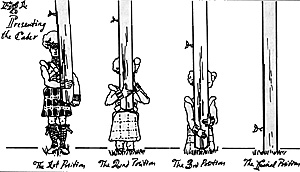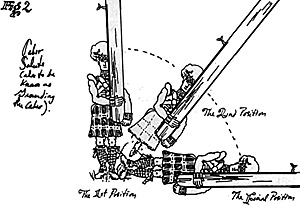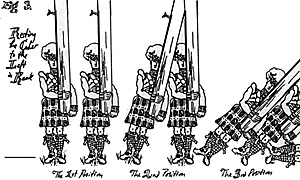"The Campbells are coming,
With cabers to Cawdor.
And when they arrive,
'Twill be a Great Slaughter."
 Most everyone, at least most every Anglo-Saxon and
supporter of Western Civilization, is familiar with that
curious but appealing Scottish sport, the tossing of the
caber. What few realize, however, is that this innocent
heaving of what looks like a trimmed-down telephone pole
has its roots, so to speak, deep in the historical military
tradition of Scotland.
Most everyone, at least most every Anglo-Saxon and
supporter of Western Civilization, is familiar with that
curious but appealing Scottish sport, the tossing of the
caber. What few realize, however, is that this innocent
heaving of what looks like a trimmed-down telephone pole
has its roots, so to speak, deep in the historical military
tradition of Scotland.
Modern collaboration between the Church, goverments and scientists hastened to conceal the knowledge of the caber's true importance in warfare. No wonder, considering the empires that have fallen and the kingdoms that have been toppled by its use. And no wonder, either, that when the medieval church relented its ban on crossbows, permitting them to be used against fellow Christians on Mondays, Wednesdays and alternate Fridays, and on the heathen every day of the week, the caber was still forbidden in battle by the Pope himself. But the caber as a weapon is much older than this.
David and Goliath
Perhaps the most famous battle in the Old Testament was that between David and Goliath. The authors, who between them are fluent in Ancient Hebrew, ProtoSyrian, Cripple Greek and Pig Latin, have studied the original texts of the Bible and discovered that sometime during the Middle Ages, when the Bible was being revised, someone inserted the word "sling" for "caber" (Gr. "kybro") throughout the text.
Any logical person can easily see that the death of Goliath, who stood fully six cubits and a span tall (roughly 10 feet and six inches), could scarcely have been caused by a pebble, whether it came from a sling or a Bull's-Eye slingshot. A conk on the noggin with a 120-pound caber, on the other hand, seems a bit more believable.
One can just imaging Goliath laughing hisgutsoutwhile little David toted what appeared to be a log (but was acutally a finely tuned caber) across the no-man's land that separated the Israelites and the Philistines. But he stopped laughing when David neatly hoisted the pole and gave it a running flip. Too late, he realized he was facing the dreaded caber.
The Philistines had plenty of other giants - the Israelites complained that they were like grasshoppers beside these men (josh. xv, 14; judges i. 20; and Numb. xiii, 33). But they knew they could never stand against the secret power of the caber, so they fled.
The English
The English began experimenting with their own cabers, sometimes with unexpected results, such as in 1100, when King William Rufus had the misfortune to be present at a demonstration of a "super caber" in the New Forest. Sir Walter Tyrel had claimed that by feeding the strongest soldiers a diet composed of nothing but raw beef and strong ale, he could produce an army capable of hurling 40-foot, 300 pound cabers a distance of 75 feet, obliterating the Scottish cabermen before they were in range.
 At the demonstration, conducted in great secrecy in the
deepest recesses of the forest, Sir Walter, taunted by a
dare from Sir Arthur Stoop, insisted on explaining the use
of the new weapon personally. With almost superhuman
effort, he succeeded in lifting the caber into an upright
position, but then began to stagger backwards at an
accelerating rate until he backed into a boulder. He
tripped, losing control of the lethal lumber, which came
down with a crash on King William's carriage. The King,
pleading a cold, had not alighted from his vehicle, nor did
he ever do so. He was buried at Westminster Abbey
seated on the velvet cushion he had been hammered into
by Sir Walter's folly.
At the demonstration, conducted in great secrecy in the
deepest recesses of the forest, Sir Walter, taunted by a
dare from Sir Arthur Stoop, insisted on explaining the use
of the new weapon personally. With almost superhuman
effort, he succeeded in lifting the caber into an upright
position, but then began to stagger backwards at an
accelerating rate until he backed into a boulder. He
tripped, losing control of the lethal lumber, which came
down with a crash on King William's carriage. The King,
pleading a cold, had not alighted from his vehicle, nor did
he ever do so. He was buried at Westminster Abbey
seated on the velvet cushion he had been hammered into
by Sir Walter's folly.
The caber project was shelved (many of the cabers, in fact, being planed down and used as shelves in the new king's study), and the special troops, or "beefeaters", were assigned to other tasks. once again, the caber was forgotten as a weapon, being viewed more as a bringer of bad luck (especially to royalty).
Both armies dropped their caber corps, but the highland games went on, and over the years the use of the caber became second nature to thousands of burly Scots. All that was lacking was a leader capable of wielding these men and logs into a formidable fighting force. Robert the Bruce was not such a man.
"Tis a fey stickie," he would growl, "I'll hae no ta do we'it." King Robert and his men stuck with pikes, with great efficiency at Bannockburn and elsewhere.
"But what about the caber?" you may cry. "When was it used by Scottish troops in battle?"
The first reported use of cabers in formation in a major battle was at Culloden, when they were carried into battle by the famed Black Watch of the Campbell clan. Unfortunately for the Scots, the Black Watch was not serving with Bonnie Prince Charlie at the time, but with the hated Duke of Cumberland and the English army.
"There is one man in this country whom I could wish to have my friend," Prince Charles Edward Stuart had written in September of 1745, "and that is the Duke of Argyll (leader of the Campbells)." This is because the skill of the Black Watch with the caber was legendary. In fact, at Culloden it was their descent on the highlanders' flank with over 300 caberdiers (as they were then called) that decided the fate of the battle and of Scotland.
The Romans
The Romans experimented with the caber, but in typical Roman fashion attempted to issue one to every man in the Roman army, with the results that the famed Cedars of Lebanon, long-renowned as the best trees for the caber, were all chopped down, and in a generation there were no trees remaining. An attempt was made to use the puny pines of central Italy as a substitute, but these trees were so scrawny and useless that they were eventually converted to more efficient use as stakes for the fortified camps that the Romans built every night while on the march.
And so the caber fell into disuse, though several Roman Emperors (notably Trajan) attempted to conquer new provinces famed for their forests, to no avail.
Dark Ages
It remained a forgotten weapon until the Dark Ages, when Viking raiders from the icy north brought it back to the shores of Western Europe. Interestingly enough, it was another giant, Harald Hardrada, who was the first recorded wielder of the caber in the British Isles. Before Harald was dispatched at Stamford Bridge in 1066 he had bowled over scores of England's best troops, including King Harold's shieldbearer. The dire implications of this one fatality can be seen from the fact that when Harold was defeated and killed at the battle of Hastings not long thereafter, his mortal wound was from an arrow that entered his eye. At the time, his new shieldbearer was nowhere to be seen, having last been observed wandering through the English camp asking if anyone knew how to tie a square knot.
 For those of you who majored in Problems of
Suburban Demography instead of history, at this time the
Scots and the English were bitter enemies, and each
kingdom was always threatening to conquer the other and
force them to change their accent.
For those of you who majored in Problems of
Suburban Demography instead of history, at this time the
Scots and the English were bitter enemies, and each
kingdom was always threatening to conquer the other and
force them to change their accent.
The shrewd Scottish kings wasted no time in securing cabers of their own for the highland levies, and the knowledge of their presenceto the north was one of the deterrents that keptWilliam the Conqueror and his men from marching northward after their triumph over Harold.
The Scots began intensive training in the use of the caber, and it is around this time (in 1084, to be exact) that the first Highland Games was held, at Iveraray Castle, ancestral home of the Campbell clan. Several years later, they struck their first blow at England.
Malcolm, the Scottish king, led an army of 8,000 caber armed highlanders into England in 1093. As the English scurried to meet them, disaster struck. It was the Scottish custom to stack their cabers in huge stands each night, much as modern armies would stack their rifles, and unfortunately for Maclolm he tripped over one of these stacks in the dark, setting off a chain reaction of collapsing cabers that buried him under three tons of timber. His brother Donald Bane became king, and the army retreated back to Scotland.
Cabers at the ready, the Campbell troops advanced, first at a slow walk, gradually increasing their speed to a dead run. Some fell, either from the badly aimed fire of their frightened opponents or from sheer clumsiness, but others took their places. As the pipes wailed, they thundered forward, roaring their ancient battle cry "Cruachan!"
At the traditional command, "Alles uppe! (which has come down to us today as 'alley oop')" the entire first rank, over 150 sinewy Scots, halted as a man and gave their cabers a mighty toss.
With a huge crash, over 20,000 pounds of Scottish fir tumbled into the Jacobite lines, scattering men, horses and bagpipes all over the landscape.
A second line approached, but Charles' men had seen enough, and they began to flee, hotly pursued by the English dragoons, who until this time had been loitering on the edges of the battlefield, well out of musket range.
The battle was over. The caber was triumphant, not for the first time, nor for the last.
NEXT: "Up Guards!" - THE STORY OF HOW THE CABER BEAT NAPOLEON.
Back to Table of Contents -- Courier Vol. IV #4
To Courier List of Issues
To MagWeb Master Magazine List
© Copyright 1983 by The Courier Publishing Company.
This article appears in MagWeb (Magazine Web) on the Internet World Wide Web.
Other military history articles and gaming articles are available at http://www.magweb.com